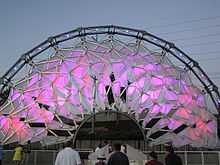Hoberman Arch
Coordinates: 40°45′32″N 111°50′52″W / 40.75889°N 111.84778°W

The Hoberman Arch was the centerpiece of the Olympic Medals Plaza in downtown Salt Lake City during the 2002 Winter Olympics. Following the Olympics the arch was moved to the Salt Lake 2002 Olympic Cauldron Park where it is now, along with the Olympic cauldron, one the main highlights and an important part of Salt Lake's Olympic legacy.
Design and History
The arch was designed by Chuck Hoberman to be used as a mechanical curtain for the Olympic Medal Plaza's stage. It is a semi-circular aluminum structure, which opened like the iris of a human eye.[1] The arch design was inspired by Utah's natural stone arches, such as Delicate Arch. At the time of its construction the arch was the largest unfolding structure in the world.[2]
It took Hoberman four months to design the arch (with support from Buro Happold), and another four months for Scenic Technologies of New Windsor, New York to build it.[3] After being constructed in their warehouse in New York it was dissembled and then trucked to Utah. It was reassembled in January 2002, and unveiled to the public and media by the Salt Lake Organizing Committee (SLOC), on January 25, 2002.[1]
When installed at the medal plaza it would open to reveal a large 3D sculpture of the 2002 Olympic logo and a second Olympic cauldron, known as the Hero's Cauldron. The stage not only hosted award ceremonies, where the athletes received their medals, but was used as a concert venue during the Olympics; hosting many performing artists including Creed, Brooks & Dunn and the Dave Matthews Band.
Following the Olympics, plans to install the arch in some kind of park were formulated. Many of Salt Lake's citizens wanted the arch to be used in an amphitheater or some kind of concert venue, possibly at downtown's Gallivan Center or Pioneer Park. But because the arch was a symbol of the 2002 games, the United States Olympic Committee put restrictions on possible future locations for the arch (to protect Olympic sponsors from other businesses who do not have Olympic sponsor contracts).[4] Because of these restrictions, and a lack of consensus among Salt Lake's leaders on where it would go, SLOC announced plans, on December 5, 2002, to install the arch at the Salt Lake 2002 Olympic Cauldron Park.[5]
On July 30, 2003, the arch was lifted onto its new permanent base using 3 cranes.[6] It is no longer functional, although it is lit with various colored lights at night. It is located just outside the park's southern fence and is partly open which allows visitors to walk through it.

Details
The arch is 36 feet (11 m) tall, 72 feet (22 m) feet wide, and weighs 31,000 pounds (14,000 kg)[1] It is made up of 4,000 individual pieces put together as 96 connected panels and are connected with 13,000 steel rivets.[3] The 96 panels vary in size, but the largest are 9 feet (2.7 m) tall and 5 feet (1.5 m) wide. The panels are also translucent which allowed light from behind to be seen and echoed the 2002 Olympic theme Light the Fire Within. Two 30-horsepower motors controlled eight separate cables which pulled the mechanical curtain open in about 20 seconds.[1] When the arch was fully opened it had folded up into a 6 feet (1.8 m) ring, which framed the stage.
Because of the potential of strong storms during the games, the arch was built to operate in extreme weather, including up to 70-mile (110 km) -per-hour winds.[1]
References
- ↑ 1.0 1.1 1.2 1.3 1.4 Brandon Griggs (26 January 2002). "Space-Age Arch Will Serve as Medals Plaza Curtain". Salt Lake Tribune.
- ↑ "World's Largest Unfolding Arch To Form Centerpiece Of Winter Olympics' Medal Plaza" (Press release). Buro Happold. 5 November 2001. Retrieved 11 November 2010.
- ↑ 3.0 3.1 Peter Thunell (26 January 2002). "Olympic arch takes a bow". Deseret News. Retrieved 10 November 2010.
- ↑ Heather May (14 November 2002). "Oly Hurdle Trips Gallivan Center - Branding concerns may squelch arch deal". Salt Lake Tribune.
- ↑ Mike Gorrell (6 December 2002). "Arch Would Anchor U. Olympic Legacy". Salt Lake Tribune.
- ↑ Lisa Riley Roche (31 July 2003). "Hoberman arch installed at the U.". Deseret News. Retrieved 10 November 2010.